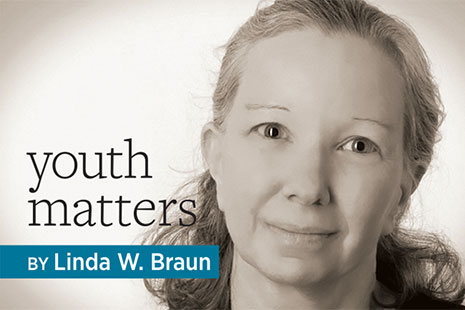
Teens deserve an environment where they feel welcome and respected. Library staff members who work with teens believe this and want to help them succeed—in having their service needs met and in life. However, even with the best intentions, teen behaviors may sometimes make it hard for staffers to keep a positive and supportive attitude.
Teens sometimes talk loudly, run around the building, or harass peers and those younger or older than themselves. They may get into fights or act carelessly with library materials. One way schools and libraries are working to help teens effectively manage these behaviors—and lessen behavior problems overall—is through restorative justice.
In a May webinar on restorative justice sponsored by the Young Adult Library Services Association (YALSA), Shauna Anderson, supervisor of young adult services at Skokie (Ill.) Public Library, defined restorative justice as “an approach to rule breaking that emphasizes the need to repair harm … and involves everyone in repairing relationships.” Restorative justice techniques may be used, for example, when teens bully a peer in the library. Parties may be asked to participate in a facilitated conversation with each other and an adult to talk about what happened, why it happened, and ways to overcome the problem and any resulting fallout. The teen “offenders” and the “victim” work together to come up with a reparative solution and next steps.
Restorative justice is a reactive process. It’s one where mending relationships is done after the fact. However, it’s possible to work in a proactive manner to help teens handle challenging social situations and preempt the occurrence of negative behaviors.
One method for doing this is talking circles. Amy Bintliff writes in Teaching Tolerance (“Talking Circles: For Restorative Justice and Beyond,” July 22, 2014) that a talking circle—sometimes called a peacemaking circle—uses a structural framework to build relationships and address conflict within a community. “Talking circles serve other purposes as well,” notes Bintliff, who used the technique when she was a reading teacher at Oregon (Wis.) Middle School. “They create safe spaces, build connections, and offer teachers a unique means of formative assessment.”
Restorative justice involves everyone in repairing relationships.
In a library setting, it’s possible to use talking circles to give teens a chance to discuss their interests, what challenges they are facing, how they feel about the environments they spend time in, concerns about friendships, and so on. Those who lead talking circles strive to give participants the chance to feel at ease with their peers, the space, and the adults working in that space. It’s an opportunity to develop relationships and a way to provide teens with skills to handle roadblocks and turn them into positive experiences.
Examples of success are abundant. The New York Times reported that restorative justice sessions helped one student view his behavior through a different lens. “‘I didn’t know how to express emotions with my mouth. I knew how to hit people,’ he said. ‘I feel I can go to someone now.’”
Want to get started integrating restorative justice practices at your library?
- Watch the YALSA Snack Break video on restorative practices in teen services and read about restorative justice at the Center for Justice and Reconciliation website.
- Connect with community leaders and organizations to discuss restorative practices and how to partner and integrate these practices into services.
- Talk with colleagues about why implementing restorative practices is a valuable approach and how it can create a welcoming environment that encourages fewer negative behaviors, interactions, and outcomes.
- Learn how to guide and implement talking circles by attending trainings with Teen Talking Circles and reading guidebooks such as the Circle Keeper’s Handbook.
- Listen to teens when they talk about how to best support their needs through restorative practices.
- Keep track of the times and ways in which teens are exhibiting negative behaviors in the library and use restorative techniques to both proactively and reactively respond to those situations.
When a library implements restorative approaches, it will likely see fewer incidents of negative behaviors requiring staff intervention and will create a welcoming environment for youth.


